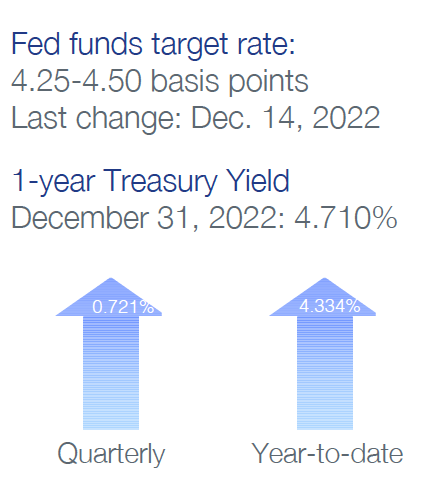Quarterly Portfolio Manager Commentary
December 31, 2022

Cash Management Portfolios
What market conditions had a direct impact on the bond market this quarter?
Economic Activity – U.S. economic growth slowed throughout the fourth quarter (Q4) amid high inflation and rising interest rates due to aggressive Federal Reserve (Fed) tightening. The slowdown was most prevalent within interest rate sensitive sectors, including housing and manufacturing, while tight labor market conditions and strong wage growth supported resilient consumer demand. Following strong 3.2% growth in the third quarter, U.S. Gross Domestic Product (GDP) growth is projected to have slowed to near 1.5% to 2.5% during Q4. U.S. consumers continue to feel the effects of high inflation and tightening financial conditions as personal spending and retail sales weakened throughout the quarter, but easing inflationary pressures led to an improvement in real personal income. Early indications suggest labor market tightness has peaked, but employment conditions remain quite firm, with November U.S. job openings standing at 10.5 million open positions versus total unemployed workers in the labor force of 5.7 million. Monthly Non-farm Payroll (NFP) gains slowed in the quarter but still averaged 247,000 jobs per month, and the U3 Unemployment Rate fell to 3.5% in December. Average Hourly Earnings remains elevated at 4.6% year-over-year (YoY), further emphasizing strong labor demand. Inflation appears to have peaked as overall inflation pressures eased throughout the quarter. The headline Consumer Price Index (CPI) declined to 7.1% in November with CPI ex. food and energy rising 6.0% YoY. The Fed’s preferred inflation index – the PCE Core Deflator Index – increased 4.7% YoY for November. Commodity prices have largely reversed the sharp increase seen earlier in the year and demand for goods has subsided, but core services price inflation rose during Q4, owing to accelerating shelter costs and wage gains. Sticky services prices are expected to keep inflation elevated during 2023 as the Fed attempts to further slow demand through tighter monetary policy..
Monetary Policy – The Fed maintained its aggressive monetary policy stance throughout the quarter, raising rates by 75 basis points (bps) at the November 2 meeting and 50 bps at the December 14 meeting. The target range for the federal funds rate is 4.25% to 4.50%, an increase of 425 bps during the year. The Fed also continued to implement its balance sheet reduction program (quantitative tightening), with a monthly cap of $60 billion in Treasury securities and $35 billion of agency mortgage-backed securities. Following the December meeting, the Federal Open Market Committee (FOMC) released its updated Summary of Economic Projections, which indicated expectations for lower real GDP growth in 2023 and 2024 compared to projections from September, as well as modestly higher unemployment and inflation over the next two years. Additionally, the Fed signaled further rate hikes will be warranted, with the current FOMC median projection for the federal funds rate at the end of 2023 to be in the range of 5.00% to 5.25%. The Fed anticipates maintaining restrictive rate policies through 2023 to loosen labor market conditions and bring inflation down toward its 2% target.
Fiscal Policy – After two years of elevated fiscal stimulus, government spending was a drag on U.S. GDP in 2022. The government’s contribution to growth is set to rebound in the coming year, however, following the passage of a $1.7 trillion spending bill that includes a 6% increase in domestic spending initiatives and a 10% increase in defense programs. Additionally, social security and disability benefits are set to rise by nearly 9% in 2023. Nevertheless, the results of the midterm elections suggest political gridlock will be the theme in Congress over the next two years and no major fiscal packages are expected during President Biden’s remaining term in office. On the municipal side, state and local governments have seen early signs of tax collections starting to slow, but strong reserves have left them in a solid position if economic conditions weaken further.
Credit Markets – Absolute fixed income returns turned positive in the fourth quarter as longer-term yields stabilized on market expectations for a slower pace to future rate hikes and an eventual pivot to late 2023 rate cuts. While the quarterly point-to-point change in yield curve levels was relatively minor, intraday and weekly interest rate volatility remained elevated. Market technical factors continue to suppress front-end T-bill yields versus repo, money market funds and other very short-term investment options.
Yield Curve Shift
|
U.S. Treasury Curve |
Yield Curve 9/30/2022 |
Yield Curve 12/31/2022 |
Change (bps) |
|---|---|---|---|
|
3 Month |
3.247% |
4.343% |
109.6 |
|
1 Year |
3.933% |
4.687% |
75.4 |
|
2 Year |
4.279% |
4.426% |
14.7 |
|
3 Year |
4.288% |
4.224% |
-6.4 |
|
5 Year |
4.090% |
4.004% |
-8.6 |
|
10 Year |
3.829% |
3.875% |
4.6 |
The rapid increase of Treasury yield curve levels through the first three quarters of the year abated in the fourth quarter. The decline in three to five-year yields was a positive performance differentiator for portfolios with exposure to the sector. The three-month to 10-year portion of the yield curve inverted by 46.8 bps after three-month T-bill yields jumped on 125 bps of Fed rate hikes in the quarter. At the same time, the two-year to 10-year portion of the yield curve inverted a further 10.1 bps to 55.1 bps.
Duration Relative Performance

*Duration estimate is as of 12/31/2022
With stabilization in yield curve levels beyond two years, absolute returns turned positive and performance dispersion for indices with maturities less than three years was muted. Indices with exposure to securities maturing in three- to five-years outperformed their shorter duration counterparts, driven by an additional 23.5 bps of inversion in the two-year to five-year portion of the yield curve.
Credit Spread Changes
|
ICE BofA Index |
OAS* (bps) 9/30/2022 |
OAS* (bps) 12/31/2022 |
Change (bps) |
|---|---|---|---|
|
1-3 Year U.S. Agency Index |
7 |
15 |
8 |
|
1-3 Year AAA U.S. Corporate and Yankees |
9 |
15 |
6 |
|
1-3 Year AA U.S. Corporate and Yankees |
38 |
39 |
1 |
|
1-3 Year A U.S. Corporate and Yankees |
82 |
72 |
-10 |
|
1-3 Year BBB U.S. Corporate and Yankees |
131 |
112 |
-19 |
|
0-3 Year AAA U.S. Fixed-Rate ABS |
76 |
80 |
4 |
Option-Adjusted Spread (OAS) measures the spread of a fixed-income instrument against the risk-free rate of return. U.S. Treasury securities generally represent the risk-free rate.
A-rated and BBB-rated corporate credit spreads tightened in the quarter, while their higher rated counterparts widened on the margin. Lower-rated issuers entered the quarter with more favorable credit spread valuations versus AA-AAA corporate credit and agency securities and benefitted from improvement in financial conditions during the quarter.
Credit Sector Relative Performance of ICE BofA Indexes

ICE BofA Index
*AAA-A Corporate index outperformed the Treasury index by 38.3 bps in the quarter.
AAA-A Corporate index underperformed the BBB Corporate index by 45.5 bps in the quarter.
U.S. Financials outperformed U.S. Non-Financials by 22.4 bps in the quarter.
Credit had a strong month versus agencies and treasuries. Down in credit outperformed higher-rated counterparts on spread compression and higher coupon income.
What strategic moves were made and why?
Taxable Portfolios – Fixed income returns turned decidedly positive after rising interest rates and aggressive Fed tightening generated significant negative year-to-date performance. The short-term yield curve flattened with short rates jumping on 125 bps of Fed rate hikes, while yields beyond two-years were relatively unchanged. Portfolios began the quarter with higher current yields, providing a cushion against interest-rate driven bond price fluctuations. Credit was a positive contributor to performance versus U.S. treasuries and agencies. A- and BBB-rated credit spreads tightened in the quarter, providing a performance boost beyond the coupon advantage of credit. Portfolio book yields continued to climb as cash flows are reinvested into higher yielding instruments. For our investment-grade universe, fundamental credit quality remains solid with minimal negative rating actions in the quarter. We do not believe any of our portfolio holdings represents a threat to principal.
Tax Exempt and Tax-Efficient Portfolios – We entered the quarter intent on adding some duration to tax-exempt mandates but were ultimately frustrated in that effort. Interest rate volatility, tied to uncertainties around the macroeconomic outlook and Fed policy, was a deterrent. The yield on three-year municipal bonds fell more than 60 bps in November - a good portion of that move occurring over just a handful of trading days. New issue municipal supply was anemic – down an astonishing 30%, or $25 billion (Q4 2022 versus Q4 2021). Given the much lower absolute yields for fixed-rate securities, as well as the tight market conditions; we became more comfortable holding allocations to Variable Rate Demand Notes (VRDNs)/money market funds steady. For the month of December, VRDNs averaged over a 3% yield - generating about 50 bps of additional income versus most short, tax-exempt alternatives.
How are you planning on positioning portfolios going forward?
Taxable Portfolios – With the Fed approaching the endgame for rate hikes, yield curve strategies will evolve from a strong bias for short to benchmark duration to a more neutral structure. Given the significant gap between Fed guidance and market expectations for the Fed’s terminal rate and for late 2023 rate cuts, we anticipate U.S. Treasury yield curve volatility to remain elevated. This implies a more tactical approach to duration and yield curve management as fair value fluctuates with key economic data and outlook updates from Fed officials. Despite continued rate volatility, we do not expect quarter-over-quarter yield curve changes will be severe enough to generate negative absolute returns in the first quarter. Corporate and asset-backed credit have value at current spreads, but intensifying recession fears and weakening corporate profitability require a more discerning approach to security selection. We will continue to selectively reinvest portfolio cash flows into credit, with an overweight toward the financial sector where spreads have more relative value and bank fundamental credit quality remains strong. Underlying credit metrics for auto, credit card and equipment loan ABS remain robust, and the sector continues to be one of our favorites. Elevated interest rate volatility provides opportunities in callable agencies to add portfolio coupon income while at the same time increasing overall portfolio credit quality.
Tax Exempt and Tax-Efficient Portfolios – Municipal market conditions are likely to remain challenging in January and February. Each of these months typically see higher reinvestment needs from bond maturities and coupon payments and lower supply. It would not be surprising to see municipal yields fall even further on the back of these strong technicals. However, tax-exempt new issuance usually picks up considerably in March, leading to a reversal in yields and improved relative value. We are also somewhat optimistic on better overall fixed income market levels in the months ahead. Looking back at previous Fed rate hike cycles, it would be unusual for treasury yields to peak (early November) so far ahead of the last hike. Currently, the futures market is pegging the last Fed hike in Q2 2023. We are of the opinion, there will be better timing to revisit the duration extension trade. It is also worth noting that VRDNs averaged about 75% of SOFR for all of 2022. If Fed funds were to average around 5% during 2023, with no cuts, the expectation of municipal cash returns would be well above current fixed-rate levels to the tune of about 150 bps. Determining a reasonably accurate forecast for both SIFMA rates and the outlook for Fed policy, will be crucial to our evaluation of municipal note/bond opportunities in the year ahead. We will make adjustment to variable versus fixed-rate allocations accordingly.
Sources
Bloomberg C1A0, CY11, CY21, CY31, G1P0, ICE Bond, JOLTTOTL, NFP TCH, PCE CYOY, US0003M, USUETOT and USURTOT Indices
Bloomberg, U.S. Economic Forecast
Bloomberg, U.S. Treasury Actives Curve
https://www.federalreserve.gov/monetarypolicy/files/monetary20221214a1.pdf
https://www.federalreserve.gov/monetarypolicy/files/fomcprojtabl20221214.pdf
https://fortune.com/2022/12/30/president-joe-biden-signs-omnibus-spending-bill-avoids-government-shutdown/



